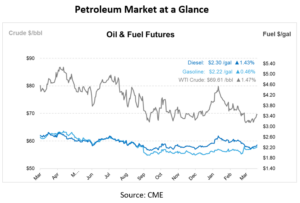
What’s That – Preventive Maintenance
Have you ever wondered how commodity industries maintain continuous operations with minimal errors or disruptions? In sectors where downtime isn’t an option, efficiency, and proactive planning are necessary for seamless performance. Preventive maintenance serves as the backbone of operational reliability, helping businesses stay ahead of potential issues before they escalate. This strategic approach involves routine, scheduled upkeep to prevent equipment failures, reduce downtime, and extend the lifespan of critical assets. In today’s “What’s That Wednesday” article, we’ll explore the key aspects of preventive maintenance and how adopting this proactive strategy can keep your business running smoothly.
What is it?
Preventive maintenance (PM) is a strategy to avoid equipment failures and extend asset lifespans. It involves regular, scheduled maintenance activities. This includes equipment, vehicles, facilities, and infrastructure. The primary goal is to proactively maintain equipment and systems by performing regular inspections and repairs to prevent unexpected problems and failures before they escalate.
Preventive maintenance strategies vary based on timing and equipment needs. Time-Based Preventive Maintenance (TBPM) follows a fixed monthly, seasonal, or annual schedule based on manufacturer recommendations and historical performance, regardless of asset condition. Usage-Based Preventive Maintenance is triggered by specific usage milestones, such as operating hours or production cycles. Condition-Based Maintenance (CBM) relies on real-time sensor data to track key performance indicators, initiating maintenance only when irregularities arise. Lastly, Predictive Maintenance (PdM) leverages advanced analytics and machine learning to forecast failures before they occur, improving efficiency and reducing unexpected downtime.
PM Versus Reactive Maintenance
Reactive maintenance, in contrast to preventive maintenance, addresses issues once they have already occurred. This is a “run-to-failure” approach, where maintenance is performed only after equipment has already broken down or malfunctioned. While reactive maintenance can be suitable for non-essential or low-cost assets, relying solely on this approach for critical equipment can lead to increased costs and operational risks. Therefore, organizations often use preventive maintenance to optimize asset reliability and performance.
What are the Main Elements of Preventive Maintenance?
Preventive maintenance is a proactive approach to asset management that involves regularly scheduled inspections, equipment servicing, and preemptive repairs of physical assets. It minimizes the chances of equipment failure and operation interruptions. Implementing a preventive maintenance program requires a detailed asset inventory, scheduling based on manufacturer recommendations and equipment usage patterns, and condition monitoring through inspections and diagnostic tools.
It involves several key elements:
- Regular Inspections: Performing routine checks for signs of wear and tear, corrosion, or misalignment to mitigate equipment failure.
- Lubrication: Applying the proper lubricants to moving parts reduces friction and wear, ensures smooth operation, and prevents overheating or premature failure.
- Cleaning: Keeping equipment free of dirt, dust, and debris prevents blockages, overheating, and contamination.
- Parts Replacement: Timely replacing worn or outdated components before they fail helps prevent unexpected downtime and maintains operational continuity.
- Adjustments and Calibrations: Regularly fine-tuning and calibrating equipment ensures it operates appropriately, maintaining efficiency and product quality.
Why Should Businesses Implement a PM program?
Preventive maintenance is valuable because it ensures that equipment and assets remain reliable, efficient, and safe. By addressing minor issues before they escalate, businesses can avoid costly repairs, production delays, and safety risks. For industries that rely on continuous operations—such as manufacturing, transportation, and energy—implementing a structured program is key to maintaining productivity and compliance. A major benefit of implementing the program is its ability to minimize downtime and enhance operational efficiency. In industries with 24/7 operations and heavy equipment, maintaining asset longevity is necessary for compliance and uninterrupted performance. For fleet managers, a proactive maintenance strategy ensures vehicles and engines remain reliable, reducing the risk of unexpected failures and keeping operations running smoothly.
At Mansfield Service Partners, our Preventive Maintenance Program offers 24/7 support to keep your operations running smoothly. With over 93 years of expertise, MSP technicians track, maintain, and schedule 4,000 units annually, minimizing downtime and maximizing equipment reliability. Partner with our dedicated MSP team today and experience a proactive maintenance strategy that sets your business apart.


